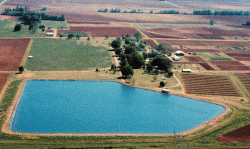- Alabama Agricultural Irrigation Information Network
- Alabama Natural Resources Council: Water Resources
- Alabama Water Watch
- ALEARN: Fisheries & Aquaculture Extension: Natural Resources
- Conservation & Rainwater Collection
- Drinking Water & Human Health
- Education & Outreach
- Environmental Restoration
- Nutrient & Pesticide Management
- Pollution Assessment & Prevention
- Wastewater & Wastewater Management
- Water Conservation & Management
- Water Policy & Economics
- Water Resources Publications
- Watershed Planning
- Workshop & Training Opportunities
- Water Resources Home
Water Conservation & Management
Although the earth is rich in water, only one percent is liquid fresh water, the form we require for our highest priority needs. The demands on this liquid fresh water are growing, and many scientists feel that a future shortage of fresh water will be eminent.
Alabama has access to a tremendous supply of fresh water, due to its long-term average annual rainfall of 55 inches, but Alabama is not immune to water shortages. A shortage of fresh water may occur for any number of reasons including rising water demands by agriculture, industry, and cities; a rapidly increasing population; pollution; flagrant waste; and unequal distribution. Increased demands and droughts both lead to accelerated pollution, and pollution can further limit the supply of available fresh water.
Better water conservation and management has economic benefits and helps protect the environment. The more water you use, the more you pay for water and sewer service on a municipal water and sewer system. Excessive water use can overload both individual septic systems and municipal sewer systems, thereby resulting in untreated sewage contamination of fresh water supplies. Water conservation can extend the useful life of both community and individual household sewer systems.
Excessive withdrawals of ground water can lead to salt water intrusion, a subtle environmental impact with long-lasting effects. These areas are usually associated with large population centers or agriculture, where water use is high. Agriculture is our most essential industry, but it is also our largest consumer of fresh water. Water conservation and management will become bigger issues for agriculture and metropolitan areas as they compete for limited fresh water resources in the future.
Water Conservation and Management in Your Watershed:
 Regardless of where you live, work or recreate, you can play a role in water conservation and management. General information on the availability of fresh water supplies in your watershed is a good starting point in helping you understand that fresh water is a finite resource. A number of local authorities or state agencies can assist you in this endeavor or with a little research, you can make your own calculations. You will learn the difference between consumptive and non-consumptive water uses, and how water from non-consumptive uses can be recycled for additional uses. You will learn that the sustainability of most human related activities in your watershed, as well as future economic growth and development, all depend on the availability of adequate fresh water resources. One of the primary attractions for any added industry to your watershed will be the availability and cost of fresh water resources.
Regardless of where you live, work or recreate, you can play a role in water conservation and management. General information on the availability of fresh water supplies in your watershed is a good starting point in helping you understand that fresh water is a finite resource. A number of local authorities or state agencies can assist you in this endeavor or with a little research, you can make your own calculations. You will learn the difference between consumptive and non-consumptive water uses, and how water from non-consumptive uses can be recycled for additional uses. You will learn that the sustainability of most human related activities in your watershed, as well as future economic growth and development, all depend on the availability of adequate fresh water resources. One of the primary attractions for any added industry to your watershed will be the availability and cost of fresh water resources.
Effective water conservation comes down to convincing individuals to implement water saving practices around their homes and businesses. Most people do not think that they waste water. That is because most people have no idea of exactly how much water they use per day. Various studies have found individual water use to range from less than 60 to over 120 gallons per person per day, sometimes with individuals in the same households. Some families and small businesses are more wasteful than others, because people simply do not know how to conserve water.

 Menu
Menu



